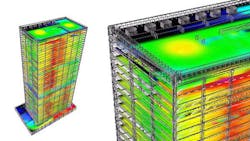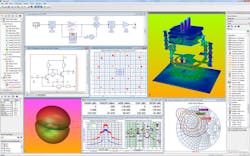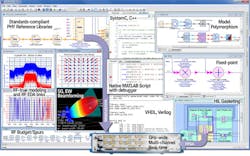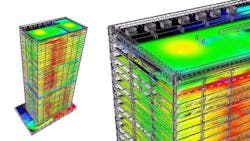This file type includes high resolution graphics and schematics when applicable.
Computer simulation software fueled by RF/microwave models is usually tasked with predicting the performance of different component-level designs. When many different components are connected, however, a system-level software simulator is required, with the capabilities of analyzing the interactions of devices, components, integrated circuits (ICs), and even the choice of printed-circuit-board (PCB) material. Over the years, such system-level simulators have grown quite sophisticated, with the capabilities to analyze the effects of different components and operating conditions on the performance of a communications system, radar, or almost any kind of system relying upon electromagnetic (EM) energy.
The increased availability of EM software simulation tools has certainly aided the effectiveness of modern system simulators and given their operators another invaluable tool for understanding how to achieve a desired level of system performance. Software simulators save the time and expense of assembling an actual system, providing simulated performance results that come strikingly close to the measured results from actual assembled prototype systems.
For many design engineers, software simulation tools are a natural starting place for a design—for example, simulating the performance of a communications receiver or transmitter by combining a number of individual component models for amplifiers, filters, antennas, and the various other components employed in a full system design. Two of the leading suites of software design tools are the Advanced Design System (ADS) suite of programs from Keysight Technologies and the Microwave Office design tools from National Instruments Applied Wave Research (AWR).
In much the same way that designers use design software to understand the effects of different matching networks on a amplifier’s gain or different transmission-line structures on a bandpass filter’s performance, system simulators offer the chance to explore the many possibilities of different design choices within a system without having to fabricate hardware and prototypes. Optimization capability has become an essential function in many system-level simulators, allowing designers to have their mainframe or personal computer (PC) run a series of algorithms in pursuit of the best performance possible from a component or set of components.
Newer suites of system-level simulation software offer EM simulation tools that are particularly useful in analyzing passive circuit and component structures (such as antennas, couplers, and filters) as well as to apply optimization functions for improved performance over an initial design. In many ways, the integration of a software tool such as an EM simulator within a system simulator can simplify the use of the former, minimizing errors due to file translations between numerous individual software programs, in addition to maintaining the models and design files in common formats.
Simulation software suites such as ADS and Microwave Office allow specifiers to add optional functionality as needed. They actually add what are complete simulation programs such as SystemVue to the ADS group of programs, along with “companion” software programs like linear and nonlinear circuit simulators and EM simulators. While a system simulator such as SystemVue is a powerful modeling tool on its own, it is the capability to apply those other simulators that makes the simulation software suite so effective. The ease of moving design files from one simulator to another has greatly simplified what was once a difficult (if not impossible) task: transferring a simulation file from one manufacturer’s software program to another.
For example, ADS also incorporates the Genesys circuit-level synthesis and simulation software for creating subsystem circuit boards to be part of a larger system. Genesys in and of itself is a full-featured simulator with extended capabilities, including nonlinear circuit simulation in the DC, time, and frequency domains; modulated RF circuit analysis; 3D planar EM simulation; and even basic RF system layouts and analysis. Core building blocks include the capabilities to create schematic diagrams, circuit layouts, perform linear analysis, apply optimization techniques, and link to test equipment for validation of models and simulations.
When creating a layout with Genesys (Fig. 1), a 3D viewer provides numerous tools—including interactive zoom, rotation, and vertical stretching functions—to verify that a layout geometry is as close to optimum as possible before commencing fabrication of a design. The software can import and export the masks and drill files needed to create a layout, using the standard PCB file formats (e.g., Gerber, DXF/DWG, and GDSII files). This simulator is augmented by more than 30,000 parts models for linear and nonlinear devices and components and system-level assemblies, including a full library of pad and package layout footprints to speed and simplify the process of creating a circuit or system layout.
The Genesys program includes a function known as Testlink, which serves as an interface between commercial test instruments (like oscilloscopes, vector network analyzers, and spectrum analyzers) and the simulation software. As expected, the software supports leading Keysight instruments but actually works with more than 140 instruments from a total of 14 different manufacturers. For many system designers, a program like Genesys is a starting point for a design such as a transmitter or a receiver, since it accepts component files, such as filters and amplifiers, that may have been previously created, and allows a user to combine those files create a larger, system-level file for simulation.
This file type includes high resolution graphics and schematics when applicable.
Additional Options
This file type includes high resolution graphics and schematics when applicable.
By operating in SystemVue (Fig. 2), ADS software users can take full advantage of a system-level vantage point on a design, while still employing the full power of the linear and nonlinear circuit simulators and EM simulation tools within ADS. SystemVue is an effective tool for predicting the interaction of analog and digital components and subsystems, including data converters, digital-signal-processing (DSP) ICs, and even field-programmable gate arrays (FPGAs), with a wide range of commercial, industrial, and military systems. As the firm likes to phase it, SystemVue is a true electronic-system-level (ESL) simulator that provides the shortest path from imagination to reality for developing these different systems.
Similarly, Microwave Office contains numerous programs, such as linear and nonlinear circuit simulators and 3D planar EM simulation software, that work in support of the main system simulation tool, Visual System Simulator (VSS). VSS, which was developed for modeling and simulating wireless communications systems, is based on the Unified Data Model architecture also employed in Microwave Office. VSS can be targeted towards simulating specific wireless standards, such as the VSS for Long Term Evolution (LTE) software, for simulating components and system assemblies intended for that wireless communications standard.
The software allows an operator to simulate all the performance levels detailed in the LTE standards, including data download rates of 50 Mb/s and as fast as 100 Mb/s; a variety of different modulation formats, such as quadrature-phase-shift-keying (QPSK) and 64-state quadrature-amplitude-modulation (64QAM) formats; scalable network carrier bandwidths, from 1.4 to 20.0 MHz; and even the effects of different levels of error vector modulation (EVM) distortion on LTE communications system performance.
For working with test instruments and measurement data, VSS features plug-and-play support for such software as LabVIEW, MATLAB, and C++ code, and links readily with NI AWR’s LabVIEW and TestWave measurement programs for ease of connection of simulations with commercial measurement equipment. The combination of hardware and software can even perform some high-level system analysis on a communications system such as an LTE wireless network, including adjacent channel interference (ACI) analysis.
As with circuit simulators, models are essential to the success of a system-level simulator, and simulators such as SystemVue and VSS are supplied with a wide range of models typically based on measurements with the software developer’s test equipment. Most of the models are at the component level, such as analog RF/microwave components including amplifiers, antennas, filters, and mixers to simplify the design of receivers and transmitters.
But some models also address the needs of digital designers, including models of data converters. System simulators make it possible to “exercise” digital components under different system operating conditions, including at different clock frequencies, bit levels, noise levels, and operating power levels. Effective system simulators can provide a prediction of the overall system performance, as well as a close-up view of interactions between components [such as the effects of impedance mismatches between a low-noise amplifier (LNA) and a frequency mixer in a receiver].
System-level software suites are designed for performing co-simulation with different software simulation engines running at the same time. In the case of the LNA and mixer connection, a number of different simulation tools may be operating simultaneously—with changes of impedance between the two components between studies with linear and nonlinear circuit simulators, and by EM and system-level simulators—to study simple effects such as changes in gain and noise figure. They also study more complex effects such as the generation of second-, third-, and higher-order intermodulation distortion within the two components and how the distortion levels will affect a system parameter, such as receiver sensitivity and range.
Of course, with the capabilities of a system simulator, many variations must be considered. Changes to any component or junction within a receiver block diagram can affect performance, right down to the circuit-board level. Thus, the capability to perform co-simulation within a suite of simulation programs makes it possible to predict the effects of literally thousands of variables and the results on system-level performance. These co-simulation engines generally run in the background of a system-level graphical user interface (GUI), without need of direct control by the user, with the user just working through the system-level control screen.
SystemVision software from Mentor Graphics is a powerful system simulation tool that provides a straightforward user interface to a multidiscipline collection of simulation tools for modeling analog, digital, and mixed-signals circuits and subsystems. It is available with the SystemVision conneXion (SVX) capability for connection to other software tools, such as Simulink from MathWorks and LabVIEW, and provides an effective means for modeling specific types of communications networks, notably controller-area-network (CAN) based systems.
For budget-conscious users, Arden Technologies recently introduced the latest version of their versatile system simulator, SysCalc6, which has been applied quite effectively over the years by both military and commercial communications users. For a fraction of the cost of the software suites, this dedicated system simulator can provide all the major system-level parameters while running on a PC, including system gain, cumulative noise figure, effective noise figure, and output noise power.
The software can save the most complex designs in flexible XML files, and provides a straightforward user interface that simplifies simulations setups. Impedance matching between system modular stages can be entered directly into a simulation and fine-tuned to experiment with different effects and operating conditions and achieve an optimum design layout. What the program may lack in terms of its hardware test heritage compared to the two major system software suites it provides in ease of use and speed in achieving accurate system-level simulations.
In some cases, simulation of system performance may rely heavily on the propagation environment. Design software such as iBwave Design (Version 6.6) from iBwave models the performance of wireless communications transmitters and receivers within a building (Fig. 3). The software can plot the performance of multiple-carrier systems operating with voice and data transmission capabilities by using a proprietary propagation algorithm to predict the effects of the physical environment on the transmission and reception of high-frequency modulated radio waves.
The software has helped with the installation of wireless communications equipment within buildings, including the number of required antennas and the optimum placement of those antennas, the selection of different components for the system, and even minimizing the costs of equipment installation and system testing.
Similarly, the HERALD Professional software from Radio Engineering Services provides simulation of radio links, such as point-to-point radio connections, and makes it possible to predict the effects of changing weather and atmospheric conditions on the transmission and reception of high-frequency radio waves. Such system-level programs represent the next step after a software suite such as ADS or Microwave Office has eased the way for the development of the various hardware components required for an in-building wireless communications network.
In terms of learning more about system simulators, integrated-circuits (ICs) innovator Maxim Integrated Circuits offers a variety of excellent white papers on design from its website. These include the recent “Next Generation Power Modules Further Simplify Power Design,” which details how to combine models and measurements from different sources to complete a system simulation.
With references to the NI AWR and Keysight system simulators, the white paper notes that the integration of such tools as nonlinear circuit simulators and 3D EM simulators has made system simulators considerably more effective in modeling complex systems, including those involved with generating and moderating system power.
This file type includes high resolution graphics and schematics when applicable.
About the Author
Jack Browne
Technical Contributor
Jack Browne, Technical Contributor, has worked in technical publishing for over 30 years. He managed the content and production of three technical journals while at the American Institute of Physics, including Medical Physics and the Journal of Vacuum Science & Technology. He has been a Publisher and Editor for Penton Media, started the firm’s Wireless Symposium & Exhibition trade show in 1993, and currently serves as Technical Contributor for that company's Microwaves & RF magazine. Browne, who holds a BS in Mathematics from City College of New York and BA degrees in English and Philosophy from Fordham University, is a member of the IEEE.




